The history of CSC working uniforms
Standardized uniforms have been part of corrections in Canada for well over a century. In their most basic form, they serve as a functional means of identification and communication. They are a tool for encouraging professionalism and team building among staff. They are also a symbol of authority, reflecting the role of correctional officers as first responders in the criminal justice system of Canada. To quote the first Superintendent of Penitentiaries, Brigadier-General William St. Pierre Hughes, “The duties of penitentiary officers are partly military, partly police and largely reformatory.”
Historically, it was common for soldiers who had completed their years of military service to seek a career in corrections. Many penitentiary administrators were themselves veteran military or militia officers. As a result, penitentiary uniforms and regalia have naturally reflected Canadian and British military traditions. The uniforms of Canada’s federal penitentiaries have also reflected the philosophical and organizational shifts that the department has undergone throughout its more than 180-year history. Styles of uniform have shifted back and forth from civilian to para-military fashions.
Since first introduced around 1861, uniforms for federal correctional staff varied from one region to another across Canada. One constant was that they were navy blue in colour. Warden Samuel Bedson of Manitoba Penitentiary (Stony Mountain) designed the first standardized uniform in 1890. The first uniforms were dark blue serge (wool) and were characteristic of the early military influence. They consisted of:
- a simple tunic and vest with brass or silver buttons
- pants, and
- a peaked cap
Inmate tailors employed in industrial tailor shops manufactured them, at all five penitentiaries across the country:
- Kingston Penitentiary
- British Columbia Penitentiary
- Manitoba Penitentiary
- Dorchester, and
- St. Vincent de Paul
By 1916, most correctional officers had switched to a newer khaki uniform that remained in use with few changes until the 1960s. From 1910 to the mid-1930s, officers wore a wide-brimmed Stetson style hat similar to those worn by the Royal Canadian Mounted Police (RCMP).
Priorities within the service shifted in the early 1960s, away from a punitive approach towards a stronger philosophy of rehabilitation. Other changes within the Canadian Penitentiary Service illustrate changing attitudes towards the correctional system. A new Penitentiary Act was introduced in 1962; the Service underwent a broad administrative reorganization; a 10-year plan of new penitentiary construction was launched and a greater effort was made to focus on the quantity and quality of staff training to attract a more professional staff. The Service adopted an Air Force blue uniform that was less military in style. For the first time, professional firms outside of the Penitentiary Service manufactured the clothing.
In 1978, correctional officers again traded in their blue uIn 1978, correctional officers again traded in their blue uniforms for khakis. A new two-toned khaki beige and green-coloured uniform, and a system of elaborate military-style insignia were adopted with:
- the hope of building a common identity
- esprit-de-corps, and
- to boost professionalism.
In 1989, it was decided that it was time to develop another new uniform to coincide with the departmental-wide transition to the Unit Management System of operation in its institutions. The basis of the Unit Management System included “a greater integration of the security, living unit and case management functions”. This uniform consisted of:
- a navy blue blazer with embroidered pocket crest, and
- grey pants or skirts
A selection of shirts and clip-on neckties and scarves were also included. In addition, a navy blue ball cap with embroidered crest rather than the more formal peaked forage caps and badges was introduced. It was finally issued in 1993. Once again, the uniform reverted to a variation on the blue theme and a civilian style.
In 1999, due to concerns about the semi-formal/business style and functionality of this uniform, a new process to find a more appropriate design began. In 2005, an entirely new uniform was unveiled. This uniform consists of:
- highly functional dark blue cargo pants, and
- a black t-shirt under a dark blue permanent press shirt:
- available in both long and short sleeves with:
- departmental shoulder flashes, and
- epaulettes on the shoulders
Rank insignia consists of embroidered gold bars on navy blue epaulettes. Correctional managers wear light blue shirts to make them more readily identifiable in emergencies. The new uniform also includes a higher quality baseball-style cap with the service badge embroidered on the front and CSC/SCC embroidered in gold on the back. In 2009, stab and ballistic resistant vests became standard issue. In March of 2018, a versatile 3-in-1 jacket became standard outerwear issue for all security staff. Overall, this uniform is much more comfortable and rugged than the previous one.
The correctional officer uniform reflects the enormous responsibility of our correctional staff to carry out challenging duties while respecting:
- human rights
- the rule of law, and
- the highest ethical standards
Correctional officers are the ultimate first responders; they provide the combined functions of:
- police
- firefighters
- paramedics, and
- counsellors
The uniform that they proudly wear reflects these responsibilities.
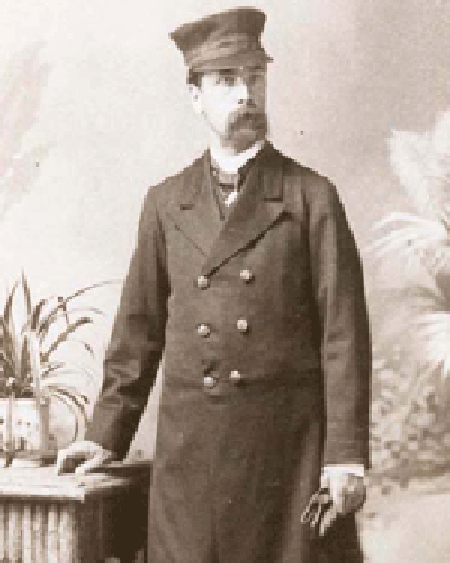
Kingston Penitentiary Officer Alexander Elsmere
is shown posing in his dress uniform.
Elsmere joined the staff of Kingston Penitentiary in 1859.
This portrait likely dates back to the 1870s or 1880s.

This is a typical Guard's uniform of the style worn from c.1910 to mid-1930s.
In the mid-1930s, the Stetson-style hat was changed to a peaked forage cap,
but the rest of the uniform remained the same until 1963-64.

This is the first CSC Commissioner's no.1 dress uniform. It belonged to Commissioner Donald R. Yeomans and is dated Sept. 1980.It represents the first uniform style worn by staff under the Correctional Service of Canada.

The first Superintendent of Penitentiary,
Brig.-Gen. William St. Pierre Hughes.
He is pictured here wearing his military uniform in World War 1. (CSC Museum Collection)

Warden Samuel Bedson, Manitoba Penitentiary (c.1880) is credited with designing the first standardized uniform for penitentiary officers, which was approved in 1890. He is pictured here wearing his military uniform. (CSC Museum Collection)

The officers of Kingston Penitentiary, c.1890. (CSC Museum Collection)
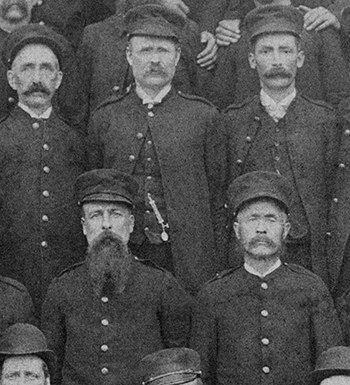
KP Officers, c.1890. (CSC Museum Collection)

Penitentiary Officer E. Coppin (c.1930) is wearing a khaki green uniform and “Stetson” style hat.
(CSC Museum Collection)

KP Officer Lattimore in khaki summer dress, 1948. (CSC Museum Collection)

The new Canadian Penitentiary Service Air-Force-Blue uniform introduced in 1963.
It continued in use, with a series of different shoulder crests, through to 1978.
(CSC Museum Collection)
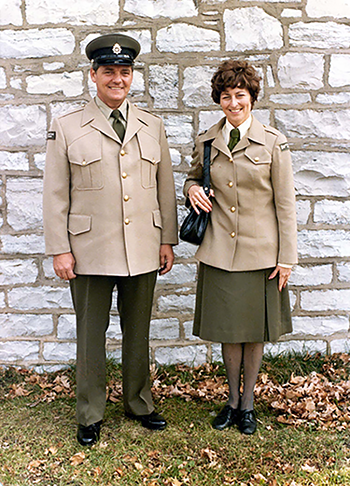
The first patternof CSC uniform introduced in 1978. The male officer is still wearing the older Penitentiaries Canada cap badge. (CSC Museum Collection)
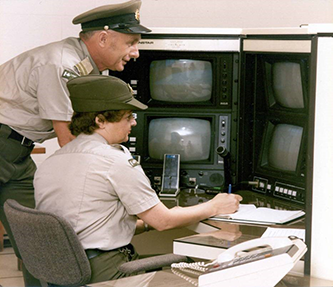
CSC officers at work, c.1980s. (CSC Museum Collection)
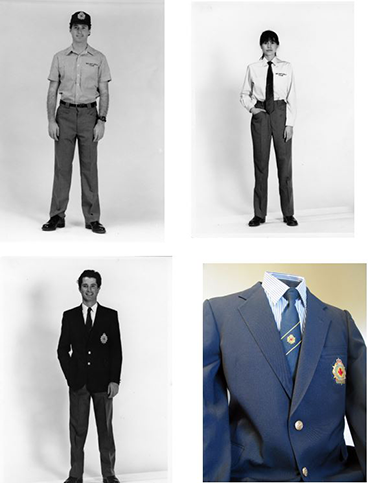
The more civilian-style CSC uniform, 1993-2005.
(CSC Museum Collection)
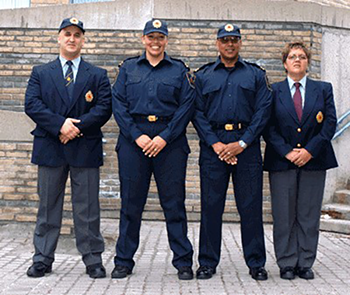
CSC officers modelling the old and new uniforms at the unveiling of the new CSC uniform in Laval, Quebec, 2005. (CSC Museum Collection)

B.C. Penitentiary Warden Whyte and his staff, c.1905.
The officers are wearing the first standardized federal penitentiary uniform.
(New Westminster Archives, IHP0272)